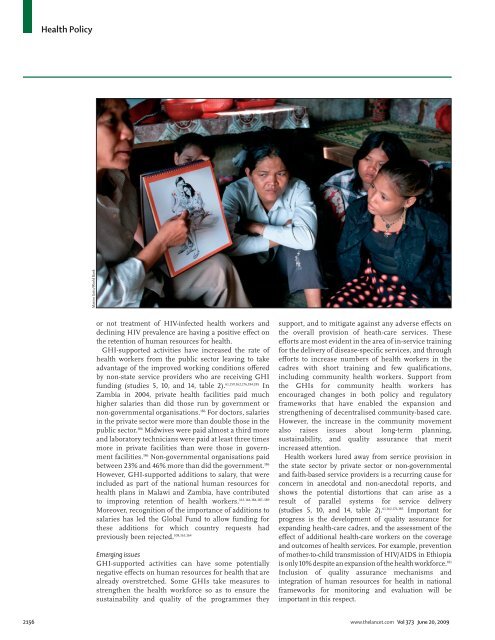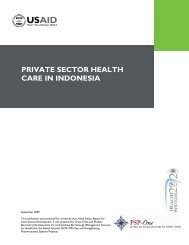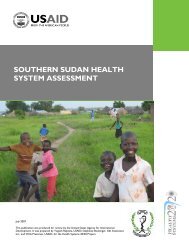An assessment of interactions between global ... - ResearchGate
An assessment of interactions between global ... - ResearchGate
An assessment of interactions between global ... - ResearchGate
Create successful ePaper yourself
Turn your PDF publications into a flip-book with our unique Google optimized e-Paper software.
Health Policy<br />
Massru Goto/World Bank<br />
or not treatment <strong>of</strong> HIV-infected health workers and<br />
declining HIV prevalence are having a positive effect on<br />
the retention <strong>of</strong> human resources for health.<br />
GHI-supported activities have increased the rate <strong>of</strong><br />
health workers from the public sector leaving to take<br />
advantage <strong>of</strong> the improved working conditions <strong>of</strong>fered<br />
by non-state service providers who are receiving GHI<br />
funding (studies 5, 10, and 14, table 2). 61,159,162,176,184,185 In<br />
Zambia in 2004, private health facilities paid much<br />
higher salaries than did those run by government or<br />
non-governmental organisations. 186 For doctors, salaries<br />
in the private sector were more than double those in the<br />
public sector. 186 Midwives were paid almost a third more<br />
and laboratory technicians were paid at least three times<br />
more in private facilities than were those in govern -<br />
ment facilities. 186 Non-governmental organisations paid<br />
<strong>between</strong> 23% and 46% more than did the government. 186<br />
However, GHI-supported additions to salary, that were<br />
included as part <strong>of</strong> the national human resources for<br />
health plans in Malawi and Zambia, have contributed<br />
to improving retention <strong>of</strong> health workers. 163,164,184,187–189<br />
Moreover, recognition <strong>of</strong> the importance <strong>of</strong> additions to<br />
salaries has led the Global Fund to allow funding for<br />
these additions for which country requests had<br />
previously been rejected. 108,163,164<br />
Emerging issues<br />
GHI-supported activities can have some potentially<br />
negative effects on human resources for health that are<br />
already overstretched. Some GHIs take measures to<br />
strengthen the health workforce so as to ensure the<br />
sustainability and quality <strong>of</strong> the programmes they<br />
support, and to mitigate against any adverse effects on<br />
the overall provision <strong>of</strong> heath-care services. These<br />
efforts are most evident in the area <strong>of</strong> in-service training<br />
for the delivery <strong>of</strong> disease-specific services, and through<br />
efforts to increase numbers <strong>of</strong> health workers in the<br />
cadres with short training and few qualifications,<br />
including com munity health workers. Support from<br />
the GHIs for community health workers has<br />
encouraged changes in both policy and regulatory<br />
frameworks that have enabled the expansion and<br />
strengthening <strong>of</strong> decentralised community-based care.<br />
However, the increase in the community movement<br />
also raises issues about long-term planning,<br />
sustainability, and quality assurance that merit<br />
increased attention.<br />
Health workers lured away from service provision in<br />
the state sector by private sector or non-governmental<br />
and faith-based service providers is a recurring cause for<br />
concern in anecdotal and non-anecdotal reports, and<br />
shows the potential distortions that can arise as a<br />
result <strong>of</strong> parallel systems for service delivery<br />
(studies 5, 10, and 14, table 2). 61,162,176,185 Important for<br />
progress is the development <strong>of</strong> quality assurance for<br />
expanding health-care cadres, and the <strong>assessment</strong> <strong>of</strong> the<br />
effect <strong>of</strong> additional health-care workers on the coverage<br />
and outcomes <strong>of</strong> health services. For example, prevention<br />
<strong>of</strong> mother-to-child transmission <strong>of</strong> HIV/AIDS in Ethiopia<br />
is only 10% despite an expansion <strong>of</strong> the health workforce. 181<br />
Inclusion <strong>of</strong> quality assurance mechanisms and<br />
integration <strong>of</strong> human resources for health in national<br />
frameworks for monitoring and evaluation will be<br />
important in this respect.<br />
2156 www.thelancet.com Vol 373 June 20, 2009
















